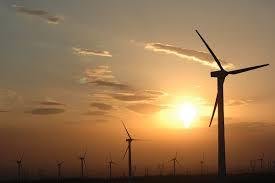Wind Power Generation In India in 2021

During March 2021, India's wind power capacity was 39.2 gigawatts (GW). According to the Global Wind Energy Council (GWEC), another 20 GW will be added over the next five years. Like solar power, wind power too can become ab important renewable energy source for India.
Since 2010, wind energy production has grown by 11.39 per cent, and wind energy capacity has grown by 8.78 per cent. The share of electricity generated by onshore wind farms is about 4 percent as on 2021.
A target of 5 GW of offshore capacity should be installed by 2022 and 30 GW by 2030, according to the Ministry of New and Renewable Energy (MNRE). These figures point to the kind of wind power potential that exists. Recent years have seen numerous challenges for the wind sector, and this year was no exception.
The sector was also heavily burdened by duties and tariffs due to the slowing economy, low tariffs, trade caps and curtailments.
While onshore wind farms are increasing, offshore wind energy has yet to be developed in India. According to the MNRE, India has 7600 km of coastline that can generate 127 GW of offshore wind power. While currently coal-fired power plants are the most important source for the power sector, but with a push for renewable sources of energy, this is likely to undergo a sea change in the coming decades.
According to the National Institute of Wind Energy (NIWE), at 100 meters hub height, wind energy can produce 302 GW of power. Nearly 95 percent of the potential is found in seven states: Andhra Pradesh, Gujarat, Karnataka, Madhya Pradesh, Maharashtra, Rajasthan, and Tamil Nadu.
Offshore Wind Energy: Benefits
A wind farm is deployed offshore when it is positioned inside water bodies. For electricity generation, they use the sea winds. There are two types of wind farms: those with fixed-foundation turbines and those with floating turbines.
Wind turbines with fixed foundations are built in shallow water, while those with floating foundations are built in deeper waters. There is still a long way to go for floating wind farms.
The distance from the shore and depth of the ocean in which offshore wind farms must be 200 nautical miles. A cable buried on the ocean floor returns electricity generated by offshore wind turbines to shore. This electricity is distributed based on priority by the coastal load centers.
In India, where land is limited and the population is increasing, large wind farms positioned over water bodies will be vital.
Offshore wind parks are far more efficient than onshore ones because offshore turbines have higher efficiency due to high winds in ocean locations. They can produce a significant amount of energy per installed capacity which requires fewer resources compared to that produced by traditional methods like coal or natural gas power plants that require many components for their operation. This makes it easier to manage cost effective electricity solutions without causing harm to our environment since there are less harmful emissions being released into the air as well as no hazardous waste created from these type of systems unlike other sources such as oil or nuclear fission reactors.
Wind turbines capture the kinetic energy of wind and convert it into electricity. The output capacity utilisation factor (CUF) is equal to average power divided by maximum power capabilities, where size determines productivity as well as local conditions such as wind availability during day or night.
Onshore wind farms have a lower CUF than offshore wind farms. This translates into longer operating hours for offshore wind power.
Increasing the size and height of offshore windmills will increase energy harvesting. Further, buildings and hills do not obstruct the flow of wind.
India has an abundance of offshore wind farms that can contribute greatly to meeting its climate commitments and energy Security goals because of the advantages of offshore wind farms.
The challenges of offshore wind power
India has also faced a number of challenges that prevented it from taking advantage of offshore wind assets. It is important to understand the challenges related to technical, regulatory, and operational aspects. Among them are:
Indian economy lacks skillful workers, substructure manufactures, and vessels for installations. Onshore wind farms require stronger foundations and structures than offshore wind farms. The cost of installation can rise as a result.
Consequently, onshore wind prices will cost less than Rs 2.8-2.9 per unit, while offshore wind prices will cost between Rs 7-9 per unit.
Storms or hurricanes can cause damage to the wind turbine as a result of waves and high winds. A wind farm's maintenance becomes more expensive and difficult as it ages.
Clearances for offshore wind power projects are likely to be granted by many Indian ministries and departments. This factor could slow down the process, resulting in delays and cost overruns.
Recommendations for offshore wind development in India
We present recommendations detailing the various elements that should be incorporated into policy, regulations, grid integration, and funding frameworks.
Reduced taxes: In India, sales of electricity and power are not subject to the GST Law. When wind power generation companies pay GST to purchase goods and/or services for the project, they cannot claim input tax credits. This is an anomaly that the Indian government needs to correct at the earliest.
Imported components are essential for wind farms. A large amount of taxes must be paid to acquire turbines, transformers, inverters, and evacuation infrastructure. Early project development will be more affordable if excise duties and GST are waived.
Offshore wind power procurement can be required by feed-in tariffs (FiTs) adopted by distribution companies. It is possible to tailor FIT for each individual wind farm offshore. In the early stages of development, offshore wind energy can be promoted by the introduction of foreign direct investment until it becomes economically viable.
Purchase Agreement for renewables : In order to meet increasing demands for clean energy, the Indian government has set up renewable purchase obligations. Non-solar and solar obligated entities can now buy green power as part of their total electricity consumption through a renewables obligation scheme.
MNRE is responsible for setting RPO targets just like it does with the solar target scheme.
Renewable energy production is made less risky by long-term contracts and price guarantees, encouraging investment and development that would not normally be possible. As well as ensuring prioritization of offshore wind projects, discoms can assure priority payments.
An alternative to charging the same tariff over the project's lifetime could be a 'front-loaded' FiT agreement. In this arrangement, a higher tariff would be assessed during the project's early years, and would decrease over time. As a result, offshore wind projects can be provided with greater financial support.
State load dispatch centers (SLDCs) are unable to absorb large amounts of power generated by offshore wind projects due to curtailment concerns. A "deemed generation provision" can be applied to offshore wind. A compensation can be provided from the state or regional unscheduled interchange pool by SLDCs / regional load dispatch centers.
In India, the Power Grid Corporation of India Ltd may develop subsea substations and underwater power evacuation systems. By doing so, offshore wind farm developers would have less risk to deal with.
Visit our website: Power Distribution Reform In India
Post Your Ad Here

Comments